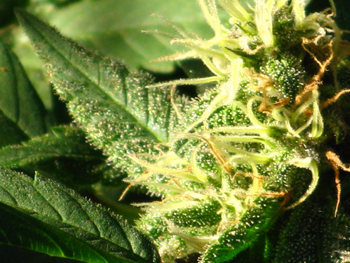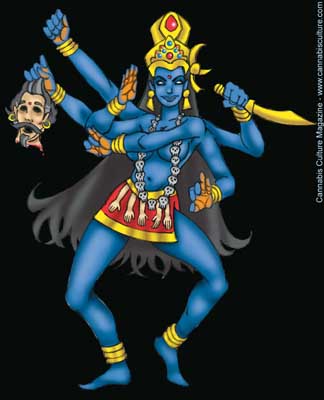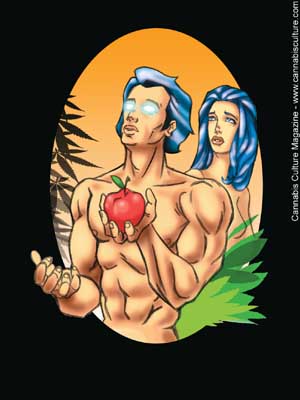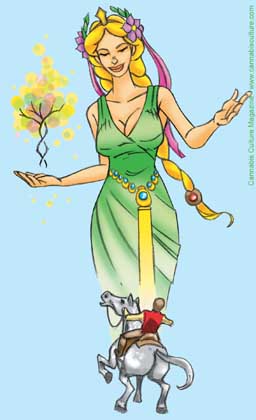
There is ample proof that indicates that man has been using marijuana since the pre-historic times. Normally, the use of marijuana by man is estimated to date back to about 10,000 years ago, but findings at a pre-historic village unearthed in Taiwan in 1972 indicates that the herb has been in use since time immemorial. Ruins of earthenware found in this pre-historic Taiwanese village sustained marks of hemp (a narcotic drug made from plant found in Asia that is smoked, chewed, eaten or drunk to produce a mild euphoric reaction) twines providing proof that marijuana has been used by men in this part of the world since the Stone Age.
According to the Chinese language, marijuana is known as ‘Ma’. It is an enduring aromatic plant that grows once a year and perhaps known to be the ‘mother’ of all civilizations depending on agriculture. For the ancient man, ‘Ma’ was not only a never ending source of food, but the herb also provided sturdy fiber for producing long-lasting ropes and cloth. In fact, while the pre-historic man in most other civilizations continued to hunt and collect food for survival, these two virtues of ‘Ma’ put China at the forefront by establishing an advanced agriculture-based industry. In addition to its medicinal, textile and other uses, marijuana seeds offer high quantities of protein, B vitamins and essential amino acids. Thus, it is little surprising that these marijuana seeds have served as the second or third most essential resource of foodstuff in China for thousands of years.
It is interesting to note that excavations in the ruins of the Nile civilization in Egypt have revealed that the people there used marijuana for its medicinal properties since as early as the 16th century. Similarly, diggings at the primeval Hebrew civilization sites also prove that they used marijuana as a therapy during childbirth since long before the birth of Jesus Christ. Therefore, there is little doubt that the multifaceted properties and uses of marijuana have demonstrated to be a priceless reserve for the continued existence of the Chinese culture since days immemorial to the present.
Significantly, the most primitive substance that was recognized as fabric from the hemp was discovered in a primeval burial site said to belong to the Chou Dynasty (1122-1249 B.C.) in China. This discovery of this hemp fabric corroborated the numerous mentions in history regarding the significance of help in ancient China. According to the instructions in the Book of Rites (compiled in 200 B.C.), the mourners in China were required to wear clothes made from hemp fabric as this was considered to be a way to show respect to the departed soul. Incidentally, this ancient tradition is still followed in several parts of China even today.
However, what is of greater significance is the innovation of the hemp paper by the Chinese as early as 200 B.C. This invention not only helped the early Chinese to maintain all their records, but also enabled them to perform an elementary task – run the government in a methodical manner. The Chinese were successful in keeping in secret the invention as well as the process of making paper from hemp fiber for as long as 900 years, eventually paper manufactured from hemp became crucial for the speedy progress of all the civilizations across the world. Significantly, several thousand years before paper made from hemp became a crucial aspect of the European civilizations, China – a nation historically known to the world as the land of hemp and mulberry – had advanced by leaps and bounds in utilizing the therapeutic and industrialized use of ‘Ma’ or the marijuana.
Medicine practitioners in early China carved the hemp stems into decorative snake-like figures and believed that they acted as good luck charm and helped in getting rid of devils or evil spirits which were considered to be the basis of all corporal ailments. The healing process of these medicine men too was peculiar. They tried to cure all types of diseases by thumping the headboards of the patients’ beds with the flamboyant mysterious hemp stalks while narrating magic charms and invocations to drive away the demons. In Japan, the Shinto priests also performed a comparable ritual by using a small baton conjoined with hemp fibers that are not dyed. This was done with the belief that the serenity of the white hemp stalks would be more effectual in getting rid of the evil spirits and hence the diseases. While modern day science as well as progressive-thinking masses may reject these rituals as mere superstitions, considering the origins of such
ceremonies, there may still be reasons for some observers to give such long-standing traditions a thought.
According to myth as well as history, Chinese emperor Shen-Nung, who ruled the Himalayan nation around 2800 B.C. is said to have introduced different medicines to his people. His name is often mentioned in myths as well as in historical references. According to a myth, emperor Shen-Nung reportedly had a transparent abdomen and he deliberately consumed at least 70 special herbs and plants daily. He practiced this to observe the consequences of these herbs and identify their different properties and usefulness. This way, Shen-Nung is believed to have discovered hundreds of various kinds of medicines for different ailments. His findings are recorded in the world’s oldest manuscript on medicines – ‘Pen Ts’ao’. For his unique efforts, people considered emperor Shen-Nung as sacred and till date the Chinese consider him as the father of their traditional medicine.
Pen Ts’ao says that ‘ma-fen’ or the flowers of the female marijuana plant comprise maximum amount of yin (the principle of darkness, negativity, and femininity in Chinese philosophy that is the counterpart of yang) force. According to the Chinese philosophy, yin is the accessible female trait and in their traditional philosophy and medicine it is vigorously related to yang – the ingenious male constituent. In ancient China, medicine men recommended the use of ma-fen to reinstate the loss of yin in people. For instance, the herbal element is administered to women suffering from exhaustion during menstruation, to cure rheumatism (firmness in joints and muscles), malaria, beri-beri (a degenerative disease of the nerves caused by vitamin deficiency), constipation and even absent-mindedness or forgetfulness. However, it has been warned in Pen Ts’ao that consuming marijuana seeds in excess and over a long period may lead an individual to see the
demons. It also says that ingesting the Ma seeds for prolonged periods may also help one to communicate with the spirits. Apart from telling his people about the different therapeutic uses of the marijuana or Ma, the Chinese emperor Shen-Nung also offered advice and lessons on cultivating hemp for clothing and other textile utilities. Incidentally, in many rural regions of China, people still follow his training in cultivating the hemp.
Bizarrely enough, alchemists (early chemists who sought to transform base metals into gold and discover a life-prolonging elixir) of the Tao era in the first century A.D. breathed in smokes of the burning hemp seeds with a view to get visions that were treasured as an approach to achieve immortality. In fact, in ancient China people believed that marijuana was a better quality elixir (a substance which was once thought to extend life indefinitely) that could refresh the mind as well as the body. Conventional Chinese medical practitioners have used Ma or marijuana pragmatically to cure different kinds of ailments. In the second century A.D., a famous Chinese surgeon called Hua T’o undertook difficult operations using ma-yo, an anesthetic prepared by blending marijuana resin and wine. It has been stated that when application of acupuncture and medications failed to cure certain problems, Ho performed complicated surgeries like amputation and even organ
grafting fastened with sutures (a thread or wire used to close a wound or connect tissues). It is reported that the use of ma-yo as an anesthesia made even such crucial and difficult operations painless for the patients. In the 10 the century A.D., a group of Chinese medical practitioners found that ma-yo proved to be effectual in healing waste diseases and injuries. On the other hand, physicians used Ma to absolve the blood of impurities and bring down temperatures during fevers. Medicines prepared from the herb were also said to be effective in healing rheumatism and for trouble-free childbirths.
Like in China, right through history, long-lasting textile manufactured from sturdy hemp stems have been of incalculable importance in the Western civilizations too. Hemp was known as kannabis in Greece and ancient records on kannabis trade show that as early as the sixth century B.C., the Greek sailors did brisk business in the herb across the Aegean Sea. During the 20th century, archeologists discovered hemp fiber in the cargo space of a Carthaginian cargo vessel that had gone down near Sicily approximately 300 B.C. Mention of use of hemp fiber by the Greek is also found in the writings of the great Greek historian Herodotus. In 450 B.C., Herodotus wrote about the superior value of hemp textile produced by the Greek-speaking Thracians.
Another Greek historian Plutarch wrote that the Thracians followed a custom of throwing the apex of the kannabis plants into fire in order to get intoxicated by the smoke billowing out of the flames. Incidentally, this custom was unknown to the Greeks, who loved wine a lot. A piece of Greek literature from approximately 400 B.C. gives some hint about the usefulness of kannabis as a remedy for backache and this, incidentally, is the only known reference of medical use of the herb in ancient Greece. On the other hand, the Hebrew as well as the Arabic medical practitioners were aware of the different therapeutic advantages of kannabis during the same period and used it to cure various disorders.
Incidentally, in 70 A.D. a Greek medical practitioner called Dioscorides utilized the opportunity of the victory over the Roman masses by pulling together valuable information on different medicinal plants. In his book titled ‘Materia Medica’, Dioscorides poured out his experiences during his journeys with the Roman army and has described various herbs and their usefulness in healing different diseases. In all, Dioscorides has recorded 600 different medicinal plants and provided detailed descriptions, local names, normal habitations as well as their uses in treating different symptoms or ailments. Cannabis sativa L. that has been derived from the Greek work kannabis also finds mention among the 600 different varieties of herbs listed by Dioscorides. In his book, the physician wrote that the herb was valuable for rope manufacture as well as generation of seeds whose juicy extract was effectual in healing earaches as well as withdrawing sexual urge.
‘Materia Medica’ written by Dioscorides proved to be a huge success and was translated into several languages around the globe. Most importantly, the book remained an important medical manual and essential reference text of the Western medical world for over 1500 years.
It is interesting to note that the English term ‘canvas’ has derived its name from the Greek word cannabis. This is ample evidence of the utmost importance accorded to the hemp textile by the European maritime technology. There is a firm belief among a section of historians that it would have been impossible for the different European empires to extend their territories across the seas without the advancement of the technologies involving the cannabis fiber. For instance, in 1492, during one of his trans-Atlantic missions, a vessel of Columbus carried over 80 tons of hemp rigging (ropes) and sails that were manufactured by people over hundreds of thousand hours. Significantly, history suggests that numerous imperial riches were a result of the hard work of the peasants in the fields cultivating hemp. It may be mentioned here that in those days, hemp had emerged as the most vital industrial crop in many developing countries across the world. It would
be noteworthy that while hemp was the most important industrial crop, during the same period the European physicians’ knowledge about the medicinal benefits of cannabis was only restricted to the references made by Dioscorides in his prized text ‘Materia Medica’ and some folk references that were handed over from the medieval period.
Medical science developed in the Western civilization as the Dark Ages gave into the Renaissance period. It was then that the scientists and physicians of the Western civilization discovered several crucial facts regarding the herbal medicines, including the various noteworthy therapeutic values of the marijuana. In his book titled ‘The Anatomy of Melancholy’ published in 1621, Robert Burton recommended that cannabis may be useful in curing depression. Several years later, in 1682, The New London Dispensatory wrote in a few words the usefulness of cannabis seeds in healing coughs and jaundice and much later, in 1764, The New English Dispensatory suggested that poultices prepared by boiling hemp roots was helpful in healing irritations and swellings. Yet again in 1794, the Edinburgh New Dispensary wrote about the growing perception of the therapeutic advantages of the cannabis herb. The report suggested that cannabis was effectual in curing coughs,
venereal or sexually transmitted diseases and urinary incontinence. In his book titled ‘Complete Herbal’ published by Nicholas Culpepper in 1814, the writer took care to list all the known curative uses of the cannabis plant and incorporated all the earlier published applications of the herb to heal different disorders. In addition, Culpepper also published a few new remedial applications of the plant like alleviating colic (sudden attack of pain in the abdomen over and over again, which causes spasm, inflammation or impediment), assuaging problems associated with bowels, stopping worrying bleeding, and lessening swelling of the head as well as easing pains of the hips and joints. He also suggested the use of cannabis as a preservative for ointments and creams for the healing of burns. Incidentally, till the discovery as well as exploration of the Indian sub-continent expanded the perceptions of the Europeans, they had no idea of any psychoactive
consequences related with the use of cannabis.
Carl Linnaeus, a Swedish botanist, compiled the all inclusive reference handbook of the botanical categorization titled ‘Species Planetarium’ in 1753 and this is still regarded as the best work on this subject. In his manual, Linnaeus had included all the classifications on Cannabis sativa done by the Greek physician Dioscorides. However, soon after Linnaeus published ‘Species Planetarium’, a group of botanists from Europe came forward with the argument that the newly researched Indian variety of the cannabis plant was markedly different from the better known European Cannabis sativa that was widely cultivated for both industrial as well as therapeutic use. Few years later, in 1783, a French botanist called Jean Lamarck scrutinized both the varieties of cannabis in his compendium (a comprehensive but brief account of a subject, especially in book form) titled ‘Encyclopedia’ and observed that the Cannabis sativa variety normally cultivated for
its fiber used by the textile industry was distinguished by its height (usually 12 to 16 feet), long stems, meager undergrowth and lean leaves. In contrast, the cannabis that was indigenous to India normally grew up to a height of four to five feet when mature and had intense foliage in unkempt clusters and bore relatively expansive leaves. Lamarck named the new variety or the species found in India as Cannabis indica keeping in view the country of the plant’s origin.
All said and done, factually there are numerous sub-species of cannabis and the botanists still persist on disagreeing over their precise as well as systematic categorization. Meanwhile, most experts have agreed that broadly there are two discrete varieties of cannabis that encompass all the properties existing in the current sub-species of the plant.
Cannabis seems to have originated in China and then it seemingly spread westward across Asia, Minor Asia and the Mediterranean. As it spread over various regions, over the years different ancient cultures adopted the plant. The theory propagated by historians in the West, cannabis spread all over the world and was ultimately accepted by all civilizations across the globe. However, the conventional Hindu scriptures have a completely different story to tell. In fact, the origins of Cannabis indica, according to the Western historians and botanists, are recorded in the Vedas – the four ancient sacred books dating back to the Aryan-dominated Hindu India. The Vedas were written about 4000 years ago and cover almost all aspects of conventional Hindu life, including great myths or legends of invasions, conquests, fight back and religious as well as spiritual advancement. Among several other legends and vibrant myths, the Vedas narrate the story of how Lord
Shiva, one of the three main Hindu Gods, reinvigorated himself in the heat of the sunlight by consuming leaves of the marijuana plants. As Lord Shiva is said to have adapted leaves of the marijuana plant as his favorite diet, he is aptly known as the ‘Lord of Bhang’.
For the uninitiated, ‘bhang’ is a conventional and popular Indian beverage prepared by blending cannabis with different herbs and spices. Liked by people over the ages, ‘bhang’ is reported to be less potent than ‘ganja’ – a substance prepared from the flowering marijuana plants and used for smoking as well as eating. On the other hand, ‘charas’ comparatively more powerful than both ‘bhang’ and ‘ganja’ is prepared from the apex of the cannabis flowers while they are in full blossom. Incidentally, ‘charas’ – thick with muggy resin (a semi-solid substance secreted in the juice of some plants) – is as powerful an intoxicant as the intense or concentrated cannabis resin product called ‘hashish’. For several thousand years such invigorating marijuana products have been a part of many important facets of conventional Indian or Hindu life. They are a part of many rituals as well as plain survival issues. Interestingly, soldiers
gearing up for a battle, couples who are to wed and even devout Hindus worshipping Lord Shiva have invoked their Lord with the holy herb on almost every important occasion.
Athavaveda – the fourth book of the Vedas that has been translated into English and titled ‘The Science of Charms’ – says that ‘bhang’ is one of the ‘five kingdoms of herbs, which relieves anxiety’. Notably, this Western logic or perception does not entirely tally with the South Asian astuteness which is not restricted by Newtonian judgment. According to a Hindu myth or allegory, long before the creation of the universe the Gods had churned a cosmic mountain with a view to obtain nectar for an eternal life. It is said that marijuana plants germinated at all places where the nectar dropped on or touched the earth.
If one takes a close look at the conventional Indian medicine, he or she will find that numerous preparations of cannabis have been used to cure dissimilar disorders such as fever, dysentery, sunstroke as well as leprosy. According to traditional Indian medicine, cannabis is effectively used to absolve phlegm (thick mucus secreted by the walls of the respiratory tract, especially during a cold), speed up the digestion process, hone up the intellect, enhance the body’s preparedness as well as function as elixir vitae (a vital magic potion or a quick cure). Unlike the Western medical science, the Hindu medical practice also deals with the spiritual consciousness of a person while healing his ailments. According to the Hindu mythology, whenever any devotee offers ‘ganja’ to Lord Shiva, the ‘king of Gods’, it pleases Him. Interestingly, this relation between Lord Shiva and ‘ganja’ is believed to be precious while upholding an individual’s
physical health and emotional or psychological balance. A Hindu text titled ‘Rajvallabha’ written in the 17th century states that this wish-gratifying drug was believed to have been acquired by men on earth for the welfare of all people. It further says that those who use it regularly are full of joy and without any distress.
In the early days when the Europeans were setting up colonies in America, cultivation of hemp for industrial use had become essential for world trade. Significantly, though the government’s authorization was required to cultivate hemp, both the Old and the New World were still ignorant of the various medicinal benefits of the marijuana plant. It was only after the Europeans explored India and discovered the advantages of Cannabis indica that the Western physicians sat up and took note of it. When they learnt about the benefits of the cannabis remedies that were found in the conventional Indian medicine, medical practitioners in Europe as well as in America acted swiftly. Even the influence of the traditional medicinal values of Cannabis indica, as found in the conventional Indian herbal medicine, was too strong on them to ignore the herb anymore.
The personal physician to Queen Victoria, Sir John Russell Reynolds asserted in 1890 that cannabis was beneficial for curing dysmenorrhea or painful menstruation, migraine, neuralgia (an intermittent and often severe pain in a part of the body along the path of a nerve, especially when there is no physical change in the nerve itself), convulsions and even insomnia. Reynolds described cannabis as undoubtedly the most useful medication to cure all painful problems or disorders. However, it is yet unknown whether Reynolds or any other Western physician of the period knew about the medicinal benefits of ‘Ma’ or marijuana as was recorded by the naturalist Chinese emperor Shen-Nung over two thousand years before them.
It is interesting to note that more than 100 medical papers relating to the usefulness of cannabis for curing loss of appetite, insomnia, migraine, headache, involuntary twitching, pain, excessive coughing and withdrawal symptoms in conditions like opiate or alcohol addiction were published between 1840 and 1890. According to Sir William Osler, who is known as the ‘father of modern medicine’, cannabis was the best medicine to cure migraines. Osler wrote about this quality of cannabis in his dependable medical manual published in 1915. Although hypodermic (using needles) injection of morphine as well as the use of aspirin and other chemically prepared medicines had begun to replace the conventional herbal remedies in America at that time, still there were at least 30 different medicines prepared from cannabis available with the leading pharmaceutical firms in the country.
Presently, researchers and scientists are examining the usefulness of marijuana in curing ailments like asthma and specific types of glaucoma (an eye disorder marked by unusually high pressure within the eyeball that leads to damage of the optic disk). Researches are also being conducted to find if marijuana can control and cure epileptic seizures and the nausea or vomiting tendency caused by the radiation therapy as well as cancer chemotherapy. On the other hand, despite the fact that the use of marijuana as an intoxicant or for recreation is socially widely accepted in many parts of Asia and Africa, such usage of the plant has serious side-effects or downsides. While experts are still debating on the issue of the degree to which marijuana can be physically as well as psychologically detrimental, there is no argument on the fact that such usage of marijuana is harmful beyond doubt. According to experts and scientists, the real danger is not that much on
the physical aspect, but more on the psychological dependence on the drug. In most countries, possessing marijuana plant is considered to be illegal and is punishable by the law.
PARTS USED
Flowers, leaves, seeds.
USES
As far as medicinal treatment is concerned, marijuana has an incredibly long history dating back to thousands of years and hence it should not be amazing to know that at some point or the other marijuana has been recommended for curing almost all the prevalent diseases. It is beneficial as an analgesic as it provides relief from pain with minimum or insignificant side affects. In fact, marijuana is especially beneficial for cancer and AIDS patients who are enduring chemotherapy. Significantly enough, marijuana can also diminish neurological over activity as well as muscle contraction and hence it is very useful for people suffering from multiple sclerosis (hardening and thickening of body tissue as a result of unwarranted growth or degeneration of nerve fibers), cerebral palsy and other muscular disorders.
By lowering the blood pressure, marijuana provides effectual cure for glaucoma. Normally, glaucoma is a condition where the pressure inside the eyeball is unusually high and is also hypertensive affecting the eye disc. Marijuana is also an effectual remedy in curing asthma, menstrual pains, pain associated with childbirth and arthritis as well as rheumatism. It may also be effective in treating depressions as the herb has anti-depressant properties. At the same time, marijuana encourages as well as stimulates sleep helping patients suffering from insomnia. Even the seeds of the marijuana plant are medicinally useful and according to the Chinese medicine, they have strong and effective laxative qualities and are used to provide relief to the elderly people from constipation.
From herbs2000.com





![]()








